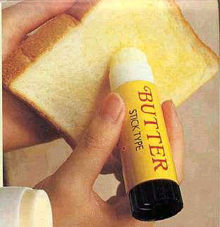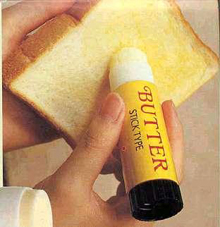 This is the final post in this series. Read Part 1 and Part 2 first if you haven’t already!
This is the final post in this series. Read Part 1 and Part 2 first if you haven’t already!
To quickly summarize, the following motivational, thought provoking questions are to be written with a big fat Sharpie on a sticky note and posted in your office, car or bathroom.
WARNING: this exercise may lead to incredible success.
1. Did you get their email address? Many marketers would agree that all businesspeople are in the “Name Accumulation” business. Whether or not you send out a newsletter, your email list of contacts is probably the most important and valuable resource you will ever own. Be sure to expand it regularly.
2. Did you listen twice as much as you talked? My dad once told me, “Scott, you have two ears and one mouth. Talk and listen proportionately.” This sticky note is a perfect way to keep your phone conversations accountable.
3. Did you look at your goals today? I don’t need to remind you how few people actually do this on a daily basis. It’s an absolute must. It takes less than five minutes. Be sure to examine both personal and professional goals.
4. Does everyone you know know what you DO? For a living, that is. What you do as a professional, for companies, for customers. Be sure your positioning statement clearly defined and posted where everyone can see it. And if a stranger asks your aunt Patty what you do for a living, ask yourself: will she do your business justice?
5. Does everyone you know know what you’re DOING? Right now, current news and projects, upcoming events. Do you have a calendar, rss feed or “upcoming events” section of your website and ezine? Are people anticipating your arrival?
6. Does everyone you know know what you’ve DONE? Past clients, past successes, whom you worked with, how you helped them. How many testimonials do you have?
7. What did you learn today? Just to be sure you’re always practicing life long learning.
8. What mistake did you learn from today? My mentor William Jenkins always said, “We learn not from our experiences, but from intelligent reflection upon those experiences.” Be sure to make mistakes often.
9. What rules did you break today? One of my goals is to break a rule every day. Nothing illegal. Nothing harmful. But by breaking rules, you are training your mind to develop an attitude of creativity, boldness and action. These small rule-breaking instances are going to accumulate and expand. Eventually, you will start thinking about the bigger picture of your career and life. The status quo. The standards. The boxes the world tries to put you in. And you will learn that Rule Breakers rule.
10. What would Grandma say? When I worked in college radio, my station manager always stressed the Grandma Rule: if you can’t say it to your Grandma, don’t say it on the air. The same rule goes for phone, email and other channels of communication. Keeping it clean never hurt anyone. Try inserting the word “Grandma” after something you’ve just said to a customer. See if it sounds acceptable.
11. Who did you refer this week? The best way to get unsolicited referrals is to give them first. Just imagine if you referred one person a week. By helping others get what they want fist, the results will come back to you tenfold.
12. Who did you WOW today? Make it your goal to delight, WOW or blow away one customer a day. After a year, that makes about 250 customers. And each of them will probably tell at least 5 other potential customers. That makes 1,250 people a year. That’s a lot of wowing.
13. Why do you love your job? A lot of audience members ask me if I love my job. My response is, “You couldn’t pay me NOT to do this job! And the day I no longer love it, I’ll quit.” So, keep looking at this reminder on a daily basis. And if you get to a point where you can’t answer it, perhaps it’s time to rethink your job situation.
14. Would you write that on the front page of The New York Times? This is an old technique. I’ve read about it in various business books over the years. Similar to the Grandma Rule, it keeps you moderately clean. What’s more, this powerful visualization technique helps you think big. Interestingly, 10 years ago it wasn’t as relevant. But not, it’s absolutely possible. One thought posted on the web from your living room could instantly be seen by millions of people across the world. Potentially, you’re only one blog post away from the front pages of the Times. Careful what you write. The Internet is forever.
15. Who did you meet today? In order to exponentially increase your activity level, setting an Encounter Quota is a great technique. Decide how many new people you’d like to meet every day (or week) and hold yourself accountable. After all, if people buy people first; and if people do business with their friends; and if people only do business with you because they’ve heard you, heard of you, or someone they trust has heard of you, doesn’t it just make sense to make friends with everybody?
16. Who did you give your business card to today? Similar to the last example. Consider setting a Card Quota. Even if it’s dropped in a sub shop bowl, stuck on a bulletin board or left on the counter, or given to someone in person, this stuff works. Especially if your card is cool. Of course, if your card isn’t cool, get a new card before you try this quota thing.
LET ME ASK YA THIS…
How do you self-motivate?
LET ME SUGGEST THIS…
Post your 3 best sticky-note success statements here!
* * * *
Scott Ginsberg
Author/Speaker/That Guy with the Nametag
www.hellomynameisscott.com

 (To read part 1 of this series, click
(To read part 1 of this series, click  (To read part 1 of this series, click
(To read part 1 of this series, click  This is a continuation of last week’s popular post,
This is a continuation of last week’s popular post,  There’s no such thing as a motivational speaker.
There’s no such thing as a motivational speaker. So I just came across a book from 1959 called Ideas That Became Big Business, by Clinton Woods.
So I just came across a book from 1959 called Ideas That Became Big Business, by Clinton Woods. 
 My girlfriend drives a pink car. It’s pretty much the sweetest ride you’ll see on the road.
My girlfriend drives a pink car. It’s pretty much the sweetest ride you’ll see on the road.  Tattoos are another great example.
Tattoos are another great example.  Another example: what if someone gets the word “hope” tattooed across her chest? Think she’d slump around all day with woe-is-me posture and depressed eyes?
Another example: what if someone gets the word “hope” tattooed across her chest? Think she’d slump around all day with woe-is-me posture and depressed eyes? I’m no expert on goal setting, but 2006 has been the best goal setting/goal achieving year EVER. Thought I’d share 25 of the gems I’ve learned…
I’m no expert on goal setting, but 2006 has been the best goal setting/goal achieving year EVER. Thought I’d share 25 of the gems I’ve learned… I used to be a
I used to be a  1. Google Alerts. These keep me in the know of my key areas of study. Additionally, they enable me to monitor of where my name, articles, blog posts and books show up around the world, especially on the Internet.
1. Google Alerts. These keep me in the know of my key areas of study. Additionally, they enable me to monitor of where my name, articles, blog posts and books show up around the world, especially on the Internet.